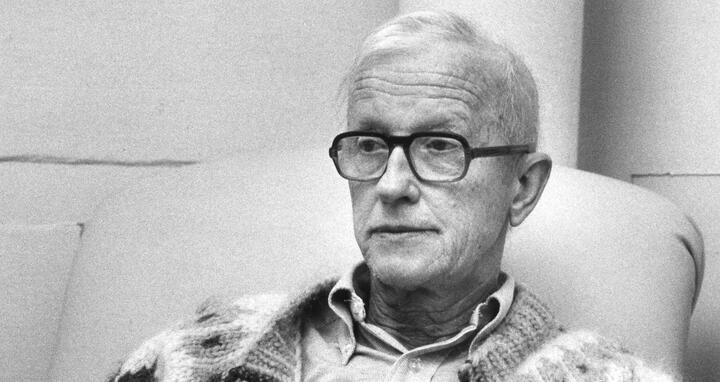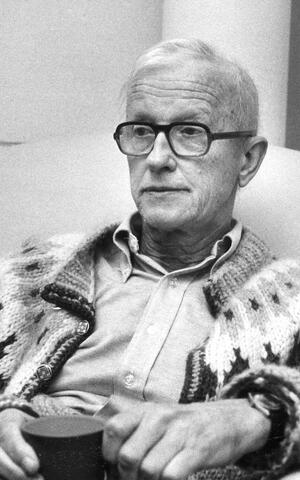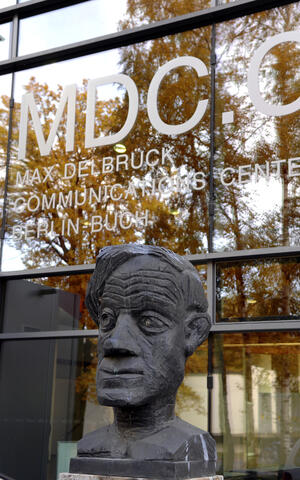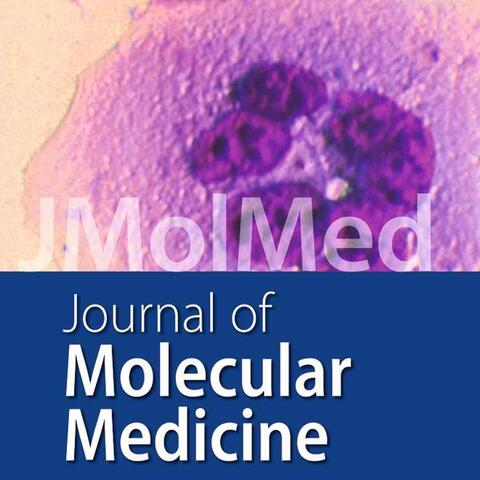Who was Max Delbrück?
Max Delbrück in seinen späten Jahren.
The MDC is named for Nobel Prize-winning biologist Max Delbrück (1906 - 1981), regarded as one of the founders of molecular biology. Delbrück never worked directly in Buch but had important life-long scientific and cultural connections to the campus and Berlin. Like many leading biologists of his generation, Delbrück began his career with a PhD in physics. After working with Wolfgang Pauli and Niels Bohr Delbrück became fascinated by the quest to discover the physical and chemical nature of the gene.
While working as an assistant to nuclear physicist Lise Meitner in Berlin, Delbrück organized scientific lectures at his house in Berlin-Grunewald. One of his early guests was Nikolai Timoféef-Ressovsky, a geneticist working at the Kaiser Wilhelm Institute for Brain Research in Berlin-Buch, later the site of the MDC. Timoféef-Ressovsky reported on a method to use X-rays to generate mutations in the fruit fly. The technique had been developed by the American biochemist Hermann Muller (later leading to a Nobel prize for Muller); he introduced it to Timoféef-Ressovsky and spent a few months working with him in Berlin-Buch in 1932-33. X-rays accelerated the search for new genes by providing a method to generate new mutations; previously, scientists had had to wait for them to appear naturally.
Bust of Nobel laureate Max Delbrück by Hans Scheib on the Campus Berlin-Buch.
Delbrück was a frequent dinner guest of Timoféef-Ressovsky and his colleague Karl Zimmer, who were discovering that increasing doses of radiation increased the number of mutations in flies. This effect was hard to explain without a theory of the chemistry and physical structure of genes, which at the time had the status of abstract concepts. The three men clearly formulated a hypothesis that others had been thinking about, which became central in the search. If genes were chemical units arranged in a linear way on chromosomes, X-rays would presumably strike random points on the chromosomes, disrupting the chemistry of any gene they hit. That meant that information from the dosage experiments could be used to calculate the size and potentially other features of genes. For the first time, genes began to take on a tangible form.
Delbrück, Timoféef-Ressovsky and Zimmer wrote up their results and speculations in a paper known as the “green pamphlet”, owing to the color of its binding. It attracted wide attention from an interdisciplinary audience including the physicist Erwin Schrödinger, who drew on its ideas in a popular work called What is Life? The two books inspired an all-out quest for the nature of the gene, which was finally resolved by James Watson and Francis Crick. The work that led to Delbrück's Nobel Prize came from a collaboration with Salvador Luria in the U.S. The two men found a way to test the hypothesis that mutations normally arise by chance, rather than as a response to environmental conditions. This resolved an argument between supporters of Darwin's theory of evolution, which holds that organisms undergo random variations and then selection, and followers of an earlier view held by Lamarck: that as organisms coped with their environments, they acquired characteristics that could be passed along through heredity. Delbrück and Luria grew bacteria in cell cultures that contained phage virus, which would kill any bacteria that didn't develop resistance. If genes were changing in response to the presence of the virus, they reasoned, then each culture dish should produce roughly the same number of survivors. Instead, the results were highly variable – which showed that random mutations were allowing the bacteria to survive.
Delbrück continued working in science until his death and gained a reputation as an excellent teacher and mentor. Throughout his life he maintained a connection to Berlin through his support of the artist Jeanne Mammen, who had painted his portrait in 1937 (it now hangs in the office of Director). Delbrück sent care packages to her and others during the war, kept her from starvation by buying several of her paintings, and compiled a photographic catalogue of her works.
This is a heavily shortened version of the original editorial by Friedrich C. Luft, referenced below.
Source
Friedrich C. Luft (2007): „Who was Max Delbrück?“ Journal of Molecular Medicine. 85(3) p. 207-11.







